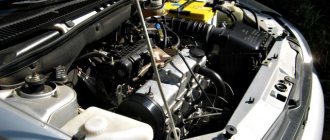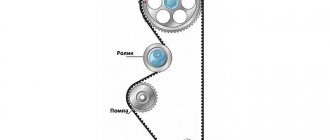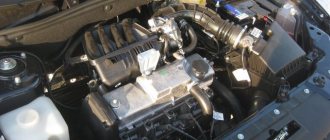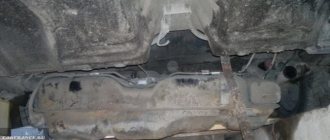Engine 11186 is the minimum power unit in terms of power. which is standard equipment on Lada Granta and Lada Kalina cars. The VAZ 11186 engine is standardly coupled with a manual transmission. The start of serial production of the engine is in 2011. Environmental standards Euro-4.
The engine is structurally designed as an in-line gasoline four with a volume of 1586 cubic centimeters. Maximum power of 87 hp. reaches at 5100 rpm. Maximum torque of 140 Nm is produced at 3800 rpm.
It is the second iteration of the modification of the classic front-wheel drive engine 21083. The predecessor is the VAZ 21114 engine with a volume of 1.6 liters. The engine has an additional index VAZ 21116. The main difference is the use of a piston system on 11186, manufactured by AvtoVAZ OJSC, and not by Federal Mogul.
The declared engine life is 200,000 km. The actual mileage before the first major overhaul is not recorded. The Russian manufacturer does not have the practice of monitoring typed cars by mileage. According to existing unverified reviews, the actual mileage exceeds the service life of 21,114, but does not reach the declared one.
SOHC engine design diagram. One camshaft located at the top of the engine. Accordingly, we have 8 valves, 2 for each cylinder. The camshaft is driven by a belt. During operation, the belt does not require replacement, since the declared life of the belt coincides with the life of the engine. The belt tension is automatic and is designed by design.
Fuel supply system is injection with electronic control. Spark plugs are standard A17DVRM. The spark is supplied by the ignition unit according to the 2-2 scheme, i.e. spark is supplied to two cylinders at the same time
Modifications applied to the engine
To ensure normal temperature conditions of 95C when using gasoline with an octane rating of at least 95, the cooling system has been modified. Changed to increase the area and flow area of the cooling channels, and increased the volume of antifreeze poured.
Changes were made to the internal channels of the engine head. To ensure increased second consumption of antifreeze, a pump from a 16-valve engine is installed on the engine. In addition, the design of the thermostat has been changed.
In order to reduce fuel consumption and increase engine reliability, major modifications have been made. The engine is equipped with a connecting rod and piston group that is lightened by almost 40% compared to the VAZ-21114 engine. This change not only reduced the weight of the engine itself, but, more importantly, reduced the inertia of the entire system. The design innovation made it possible to increase the declared service life before major repairs.
Externally, the motor also differs from its predecessor. A longer intake tract was installed, which made it possible to achieve a higher torque value and bring the performance of the 8-valve engine closer to the 16-valve engine.
The exhaust manifold has elongated pipes and a more voluminous resonator, which significantly facilitates the engine's breathing at the exhaust, since the aerodynamic resistance of the exhaust tract is reduced.
The generator mounting bracket has been changed to make it possible to adjust the drive belt using an eccentric tensioner roller. This design is also used on VAZ Vesta car engines.
Specifications
| Manufacturer | Autoconcern "AvtoVAZ" |
| Start year of release | 2011 |
| Volume, cm³ | 1596 |
| Power, l. With | 87 |
| Torque, Nm | 140 |
| Compression ratio | 10.5 |
| Cylinder block | cast iron |
| Number of cylinders | 4 |
| cylinder head | aluminum |
| Cylinder diameter, mm | 82 |
| Piston stroke, mm | 75.6 |
| Fuel injection order | 1-3-4-2 |
| Number of valves per cylinder | 2 (SOHC) |
| Timing drive | belt |
| Turbocharging | No |
| Hydraulic compensators | No |
| Valve timing regulator | No |
| Lubrication system capacity, l | 3.5 |
| Oil used | 5W-30, 5W-40, 10W-40, 15W-40 |
| Fuel supply system | injector, distributed injection |
| Fuel | gasoline AI-95 |
| Environmental standards | Euro-4/5 |
| Resource, thousand km | 160 |
| Weight, kg | 140 |
| Location | transverse |
| Tuning (potential), l. With | 180* |
*without loss of resource 120 l. With
Maintenance frequency and cost
The regulated maintenance interval is 15,000 km or 1 year, whichever comes first. The calendar maintenance period is set based on the criteria for maintaining the lubricating properties of the engine oil, taking into account its possible oxidation. The air supply system filter element is changed every 30,000 km, as are the spark plugs.
The first valve adjustment is performed after running in the engine during TO-0, then at 15,000 km during TO-1 and then at 30,000 km intervals. At TO-5 (75,000 km), the oxygen sensor is changed, and the generator drive belt is changed at 90,000 km.
The average cost of maintenance, taking into account checking other vehicle systems without the cost of consumables, does not exceed 5,000 rubles.
Timing diagram Lada Granta 8 valves
- 1 - crankshaft toothed pulley
- 2 - coolant pump toothed pulley
- 3 - tension roller
- 4 - rear protective cover
- 5 - camshaft gear pulley
- 6 - timing belt
- A - boss on the rear protective cover
- B - mark on the camshaft pulley
- C - mark on the oil pump cover
- D - mark on the crankshaft pulley.
Another feature of the engine is the location of the water pump (pump), which is rotated by the same timing belt. That is, in case of coolant leaks or characteristic noise/whistle/hum in the timing drive area, checking the belt is mandatory. If the pump bearing crumbles and the belt comes off, then in addition to replacing the water pump housing and belt, you will also have to go through the cylinder head, removing bent valves from there.
AvtoVAZ uses a very reliable Gates belt as the original belt. Often the service life of the Gates belt is much higher than the service life of the pump and tension pulley of the Lada Granta 8-valve engine.
Basic faults
Structurally, it is possible to bend the valves when the timing belt breaks. Using only the original belt avoids this problem. The problem can arise due to poor assembly, which is rare, or when the belt tension system fails. In the event of an emergency, the camshaft and even the crankshaft may be bent.
After performing repairs without replacing the main and connecting rod bearings, the pressure in the oil system may drop and oil consumption may increase. It is not possible to determine whether the valve bends when the belt actually breaks under operating conditions, since there is no open manufacturer data on such a malfunction.
Replacing the timing belt is not regulated by maintenance programs.
Troubleshooting, misfire. Failure of the ignition unit. The malfunction occurs due to a defect in the block itself. The unit cannot be repaired and must be replaced entirely.
Overheat. Associated with contamination of the surface of the cooling radiator. Another reason is a malfunction of the thermostat element, which may become stuck in the open or closed position. The most common problem is that the thermostat element is stuck in the open position, which results in a lower operating temperature of the engine.
Valve knocking. This is normal wear and tear. Eliminated by selecting adjusting washers.
The engine stalls at idle or while driving. There is a problem with the electronic sensors that the motor is equipped with. Basically, the problem is solved by replacing the mass fuel flow sensor (MAF)
Idle speed fluctuates. The reason is a problem with the idle speed sensor or due to the presence of air leaks into the vacuum brake booster (it is necessary to check the pipelines for damage).
High idle speed. This malfunction indicates a break in the crankcase gas suction pipeline.
Tuning
Initially, the manufacturer builds additional potential into its engines in order to make any changes in future versions. However, the 11186 engine can be upgraded on its own. The following type of tuning is considered standard:
- camshaft - replacement of a standard part with a Nuzhdin 10.93 or Dynamics 108 camshaft;
- cylinder block - boring to 86 - 88 mm (pistons and connecting rods of appropriate sizes will be required);
- intake manifold - zero resistance filter, damper with a diameter of 54 mm, grinding of the internal surfaces of the channels;
- catcollector - replacement with a spider having a 4:2:1 scheme;
- Timing - installation of T-shaped lightweight valves;
- Cylinder head – head milling.
Zero resistance filter
Tuning that adds 30% of power is considered safe (“resource-producing”) for the engine. That is, for 87 hp. With. it will be 29 liters. s., which results in about 115 hp. With. Further tuning becomes dangerous, since the service life will decrease in arithmetic progression. This method is used by athletes, but not by ordinary car enthusiasts.
Thus, the 11186 motor has one significant drawback - it bends the valves. The manufacturer partially corrects the situation through high-life timing belts from Gates. In other respects, the internal combustion engine was superior to its existing counterparts at that time, with the exception of the 21114 engine, which was taken as the basis.
If you have any questions, leave them in the comments below the article. We or our visitors will be happy to answer them
What volume of oil needs to be filled
When changing engine oil on a Lada Granta, you need to pour in 3.5 liters of the mixture, completely getting rid of the old lubricant. If less liquid is placed in the container, this indicates that the same composition remains in it. This is harmful to the engine, especially if the new product is different in composition.
Additionally, it is recommended to flush the engine before replacing, especially if we are talking about updating oil that has been run in from the factory.
How often, how much and what kind of oil to pour into a Priora 16 valve. Advice from experts on choosing the best engine oil for Lada Priora and debunking popular myths among motorists.
Services for selecting motor oils
A car owner who is not sure which oil should be used can use the selection service. Similar services are offered on the website of any manufacturer or in online stores specializing in the sale of fuels and lubricants.
The following are used as initial data:
An alternative selection option is to search for suitable compositions based on the required quality indicator and desired viscosity.
Examples of trustworthy resources:
What cars are equipped with the VAZ 11186 engine?
The Lada Kalina 2 and Granta with manual transmission are equipped with the 11186 engine. The engine is found on Datsun cars built on the Granta and Kalina platforms.
| Automobile model | Body | Years of manufacture |
| Lada Granta | sedan | since 2011 |
| liftback | since 2014 | |
| hatchback | since 2018 | |
| station wagon | since 2018 | |
| Lada Kalina 2 | station wagon | 2013 — 2018 |
| hatchback | 2013 — 2018 | |
| cross | 2014 — 2018 | |
| Datsun on-Do 1 | sedan | since 2014 |
| Datsun mi-Do 1 | hatchback | since 2015 |
Not all of these car models are lucky. On some the valves bend, on others they don’t. It depends on the year of manufacture and configuration.
Reviews from car owners
All oils presented in the review received positive feedback from Lada Granta owners. Car enthusiasts note their high cleaning and protective properties. Most products are rated as economical. When using them, it is rarely necessary to add oil, and the mixture remaining after replacement is enough for the entire operating interval.
Many drivers note that the engine runs much quieter with synthetic formulations than with semi-synthetic oils. Do you agree with this opinion?
Source
Synthetic or semi-synthetic
Currently there is a very extensive selection of oils
The manufacturer recommends only semi-synthetics. However, some car owners use synthetic oil, since it makes it easier for the engine to start in severe frost.
Pros of synthetic oil
Even though synthetic oil has better consumer qualities, it is still necessary to carefully monitor engine operation (vibration, speed, operating temperature (by the way, what is the operating temperature of an 8-valve engine?).
A very interesting video from “ICE Theory” about choosing oil
If you are interested in this question, be sure to watch the video below.
Source











